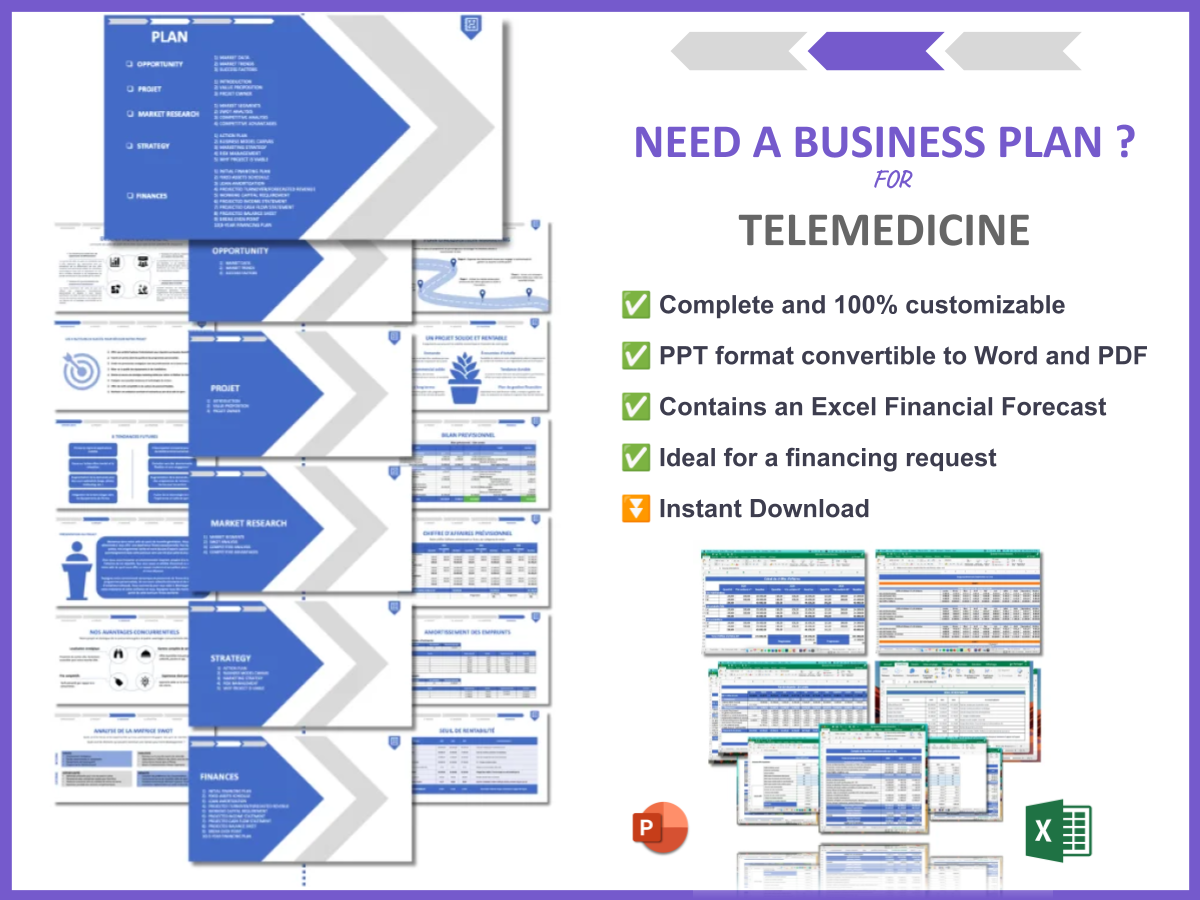Are you considering entering the world of healthcare? You’re not alone! With the rise of technology, more and more entrepreneurs are looking into how to start a telemedicine business. In fact, the telehealth market is projected to reach over $200 billion by the end of the decade. This booming field offers a unique opportunity to provide healthcare services remotely, making it accessible to a larger population. In this article, we will cover the essential steps you need to take to successfully launch your telemedicine venture.
- Understand the telemedicine landscape.
- Define your niche in telemedicine.
- Research market demand and competitors.
- Create a comprehensive business plan.
- Choose the right legal structure.
- Secure funding for your telemedicine venture.
1. Understand the Telemedicine Landscape
To start a telemedicine business, you first need to grasp the landscape of virtual healthcare. This includes familiarizing yourself with key technologies, regulations, and current trends in telehealth. The healthcare industry is evolving, and understanding these elements is crucial for your success.
- Explore current telehealth statistics: Did you know that over 75% of patients are willing to use telehealth services? This growing acceptance indicates a strong market potential.
- Identify key players in the telemedicine space: Familiarize yourself with existing telemedicine platforms and what they offer.
- Understand consumer needs and preferences: Conduct surveys or focus groups to gather insights on what patients expect from telemedicine services.
2. Define Your Niche in Telemedicine
Choosing a specific niche is crucial when figuring out how to start a telemedicine business. Whether it’s primary care, mental health, or chronic disease management, defining your niche will guide your services and marketing efforts.
| Niche | Description |
|---|---|
| Primary Care | General health consultations and follow-ups. |
| Mental Health | Therapy and counseling services. |
| Specialist Care | Consultations for specific medical conditions. |
By identifying your niche, you can tailor your services to meet the specific needs of your target audience. This focused approach will not only help you stand out in a crowded market but also attract the right clientele who will benefit from your expertise.
In conclusion, understanding the telemedicine landscape and defining your niche are foundational steps in your journey. By doing so, you’ll position yourself to meet the growing demand for remote healthcare services effectively.
3. Research Market Demand and Competitors
Conducting thorough market research is vital when you’re learning how to start a telemedicine business. You need to assess the demand for your telemedicine services and analyze your competitors to understand where you fit in the market.
- Analyze competitors’ strengths and weaknesses: Look at what other telemedicine providers are doing well and where they might be lacking. This will help you identify your unique selling proposition (USP).
- Identify gaps in the market: Are there services that are not being offered or areas where patient needs are not being fully met? Finding these gaps can give you a competitive edge.
- Gauge consumer interest through surveys: Create surveys or polls to collect data on potential patients’ preferences and needs. This direct feedback can be invaluable in shaping your offerings.
Understanding the competitive landscape will help you craft a business model that meets real needs while also standing out from the competition. It’s like having a roadmap that guides your decisions and strategies.
4. Create a Comprehensive Business Plan
Having a solid business plan is essential for any startup. A well-structured plan will not only help you organize your thoughts but will also be crucial for attracting investors. When thinking about how to start a telemedicine business, a comprehensive business plan can set the foundation for your success.
I recommend checking out this business plan template for Telemedicine. It’s super detailed and can save you a ton of time!
- Outline your business goals and objectives: Define what you want to achieve with your telemedicine service. Are you aiming for a specific number of patients within the first year? Do you have revenue targets?
- Define your marketing strategy: Detail how you plan to attract and retain patients. Will you use social media, content marketing, or partnerships with local clinics?
- Include financial projections: Estimate your costs, revenue, and break-even point. This information is crucial for both your planning and for potential investors.
| Section | Description |
|---|---|
| Executive Summary | A brief overview of your business and its goals. |
| Market Analysis | Insights into your target market and competitive landscape. |
| Operational Plan | Details on how your telemedicine service will operate. |
A comprehensive business plan serves as your roadmap, guiding your decisions and helping you stay focused on your goals. It’s not just a document; it’s a strategic tool that can pave the way for your telemedicine venture’s success.
5. Choose the Right Legal Structure
Choosing the appropriate legal structure for your telemedicine business is a significant step in how to start a telemedicine venture. The legal structure you choose will affect everything from your taxes to your personal liability. Understanding the different options available can help you make an informed decision.
- Sole Proprietorship: This is the simplest form of business entity, where you alone own the business. While it’s easy to set up, you are personally liable for any debts or legal actions.
- Limited Liability Company (LLC): An LLC offers personal liability protection, separating your personal assets from your business liabilities. This structure is often favored by healthcare entrepreneurs.
- Partnership: If you’re starting the business with someone else, a partnership allows you to share responsibilities and profits. However, it’s essential to have a solid partnership agreement to avoid conflicts.
| Legal Structure | Pros | Cons |
|---|---|---|
| Sole Proprietorship | Easy to set up and manage | Unlimited personal liability |
| LLC | Limited liability protection | More paperwork and costs to establish |
| Partnership | Shared responsibilities | Potential for disputes |
Each structure has its advantages and disadvantages, so it’s important to assess your specific needs and consult with a legal expert if necessary. This decision will lay the groundwork for how you operate your telemedicine business.
6. Secure Funding for Your Telemedicine Venture
Securing funding is often a challenging hurdle for new entrepreneurs. Understanding your financial needs is crucial when considering how to start a telemedicine business. You need to determine how much capital you will require to launch and sustain your operations.
- Consider personal savings: Many entrepreneurs start by investing their own money. While this can be risky, it shows potential investors that you believe in your business.
- Explore bank loans: Traditional bank loans can provide a significant amount of funding. Make sure to have a solid business plan to present to potential lenders.
- Look for investors: Angel investors or venture capitalists may be interested in investing in your telemedicine startup. Prepare a compelling pitch that highlights your unique value proposition.
Additionally, consider alternative funding methods such as crowdfunding or grants specifically aimed at healthcare innovations. Networking with industry professionals can also open doors to funding opportunities.
In conclusion, understanding your financial landscape and exploring various funding options will position you better for success in your telemedicine business. Securing the right funding can make all the difference in turning your vision into reality.
7. Register Your Business Officially
Once you’ve secured funding and have a clear vision for your telemedicine venture, the next step is to register your business officially. This step is crucial in how to start a telemedicine business, as it legitimizes your operations and allows you to operate legally.
- Choose a unique business name: Your business name should reflect your brand and services while being easy to remember. Ensure it’s not already in use by checking state and federal databases.
- File the necessary paperwork with your state: Depending on your chosen legal structure, you may need to file articles of incorporation or organization. This process varies by state, so check local regulations.
- Obtain a business license if required: Some states require specific licenses for healthcare-related businesses. Research your local laws to ensure compliance.
By taking these steps, you will establish your telemedicine business on solid legal ground. This not only protects you but also instills trust in your future patients.
8. Obtain Necessary Licenses and Permits
Operating a telemedicine business involves navigating various regulations and obtaining the necessary licenses and permits. This is especially important in the healthcare sector, where compliance is non-negotiable.
- Check local regulations regarding telehealth: Laws can vary significantly by state. Make sure to familiarize yourself with the rules governing telemedicine in your location.
- Ensure HIPAA compliance for patient data protection: Protecting patient information is paramount. You must implement measures to ensure that your telemedicine platform adheres to the Health Insurance Portability and Accountability Act (HIPAA).
- Consult legal experts if necessary: If you’re unsure about the licensing requirements, it’s wise to consult with a legal professional who specializes in healthcare law.
| License/Permit | Description |
|---|---|
| State Medical License | Required for healthcare providers to practice in their respective states. |
| Business License | General license to operate a business legally. |
| Telemedicine-Specific Permits | May be required depending on state laws. |
Obtaining the necessary licenses and permits is crucial for avoiding legal complications down the line. By ensuring compliance, you can focus on providing quality care to your patients without the added stress of regulatory issues.
9. Set Up Financial Management Systems
Proper financial management is key to running a successful telemedicine business. As you learn how to start a telemedicine venture, establishing a robust financial system will help you track your income, expenses, and overall financial health.
- Consider using accounting software: Tools like QuickBooks or FreshBooks can simplify your financial management. They allow you to track expenses, generate invoices, and run financial reports.
- Hire a financial advisor if needed: If managing finances isn’t your strong suit, consider hiring a professional. A financial advisor can provide guidance on budgeting, investments, and tax strategies.
- Establish a budget for your operations: Outline your expected income and expenses, including salaries, marketing costs, and technology investments. Regularly review and adjust your budget as necessary.
| Financial Task | Frequency | Responsibility |
|---|---|---|
| Income Tracking | Monthly | Owner/Bookkeeper |
| Expense Reports | Monthly | Owner/Bookkeeper |
| Budget Review | Quarterly | Owner/Financial Advisor |
By establishing effective financial management systems, you will gain better control over your telemedicine business. This control can lead to informed decision-making and improved profitability.
10. Build Your Brand Identity
Your brand is what sets you apart from competitors in the telemedicine market. Creating a memorable brand identity is essential as you navigate how to start a telemedicine business.
- Design a professional logo: Your logo is often the first impression potential patients will have of your business. Invest in quality design that reflects your mission and values.
- Develop a consistent color scheme and messaging: Choose colors and messaging that resonate with your target audience. Consistency across all platforms—website, social media, and marketing materials—builds recognition.
- Engage with your audience on social media: Utilize platforms like Facebook, Instagram, and LinkedIn to connect with potential patients. Share valuable content, health tips, and updates about your services.
Building a strong brand identity will help you attract and retain patients. It also fosters trust and credibility, which are essential in the healthcare industry.
In conclusion, your brand identity is a reflection of your values and the quality of care you provide. By investing time and effort into building it, you set the stage for long-term success in your telemedicine business.
11. Develop a User-Friendly Website
A professional website is a must-have for your telemedicine business. It serves as your online storefront, and ensuring it is user-friendly will enhance the patient experience as you learn how to start a telemedicine venture.
- Include a blog to share valuable content: Regularly updated blogs can improve your SEO and establish you as an authority in your niche. Share insights on health topics, telemedicine benefits, and patient success stories.
- Optimize for mobile users: Many patients will access your site from their smartphones. Ensure that your website is mobile-responsive to provide a seamless experience.
- Ensure easy navigation for patients: A well-organized website with clear categories and a simple layout will help users find the information they need quickly.
| Website Feature | Importance |
|---|---|
| Appointment Booking System | Allows patients to schedule consultations easily. |
| Secure Patient Portal | Enables patients to access their health information securely. |
| Contact Information | Essential for patient inquiries and support. |
By developing a user-friendly website, you enhance the accessibility of your telemedicine services. This can lead to increased patient satisfaction and retention, ultimately contributing to your business’s success.
12. Market Your Telemedicine Services
Once everything is set, it’s time to market your telemedicine services. Effective marketing is crucial for attracting patients and ensuring your business thrives as you navigate how to start a telemedicine business.
- Use social media advertising: Platforms like Facebook and Instagram allow you to target specific demographics, making it easier to reach your ideal patients.
- Engage in local community events: Participating in health fairs or community events can raise awareness about your services and build trust within your community.
- Offer promotional discounts to attract new clients: Consider offering a discount on the first consultation to encourage new patients to try your services.
By implementing a diverse marketing strategy, you can effectively promote your telemedicine services. This outreach not only increases visibility but also fosters connections with potential patients.
13. Assemble Your Team
Lastly, gathering a team of qualified professionals who share your vision is essential for your telemedicine business. As you learn how to start a telemedicine venture, building the right team will support your operational success.
- Look for individuals with telemedicine experience: Having team members who understand the unique challenges and opportunities in telehealth can greatly benefit your practice.
- Provide training to ensure quality service: Regular training sessions can help your team stay updated on best practices and technological advancements in telemedicine.
- Encourage a collaborative work environment: Foster open communication and teamwork among your staff. A supportive culture can enhance job satisfaction and improve patient care.
By assembling a strong team, you set the foundation for your telemedicine business. A motivated and skilled team can help you navigate the complexities of healthcare while providing exceptional service to your patients.
In conclusion, starting a telemedicine business involves multiple steps, from understanding the landscape to building your team. By following these guidelines, you can position yourself for success in the rapidly evolving world of telehealth.
Conclusion
Starting a telemedicine business can be a rewarding and fulfilling endeavor, especially as the demand for accessible healthcare continues to grow. By following the steps outlined in this article, you can effectively navigate the complexities of launching your telehealth venture. Remember, it’s essential to understand the market, define your niche, secure the necessary funding, and build a strong team to support your mission.
As you continue your journey, consider exploring additional resources that can enhance your knowledge. For instance, you can learn more about creating a strategic plan by reading our article on how to create a SWOT Analysis for Telemedicine. Additionally, check out our guide on how to create a Telemedicine Marketing Plan, which provides valuable insights and examples to help you promote your services effectively.
FAQ
- What is telemedicine?
Telemedicine refers to the delivery of healthcare services remotely using technology, allowing patients to consult with healthcare providers without needing to visit a physical location. - How do I start a telemedicine business?
To start a telemedicine business, you need to develop a business plan, choose a legal structure, obtain necessary licenses, and create a user-friendly website to facilitate patient interactions. - What are the legal requirements for telemedicine?
Legal requirements vary by state, but generally include obtaining a medical license, ensuring HIPAA compliance, and adhering to local regulations regarding telehealth services. - What technology do I need for telemedicine?
Essential technology includes a secure video conferencing platform, electronic health record (EHR) systems, and tools for scheduling appointments and billing. - How can I market my telemedicine services?
Effective marketing strategies include social media advertising, local community engagement, and offering promotional discounts to attract new patients. - What are the benefits of telemedicine?
Telemedicine offers numerous benefits, such as increased accessibility to healthcare, convenience for patients, and reduced travel time and costs. - Is telemedicine covered by insurance?
Many insurance providers cover telemedicine services, but coverage varies by plan. It’s essential to verify coverage options with specific insurers. - How do I ensure patient privacy in telemedicine?
To protect patient privacy, ensure that your platform is HIPAA-compliant, utilize secure communication channels, and train staff on confidentiality practices. - What types of services can be offered through telemedicine?
Services can include primary care consultations, mental health therapy, chronic disease management, and follow-up visits. - What challenges might I face when starting a telemedicine business?
Challenges can include navigating regulations, securing funding, ensuring technology reliability, and building a patient base.







